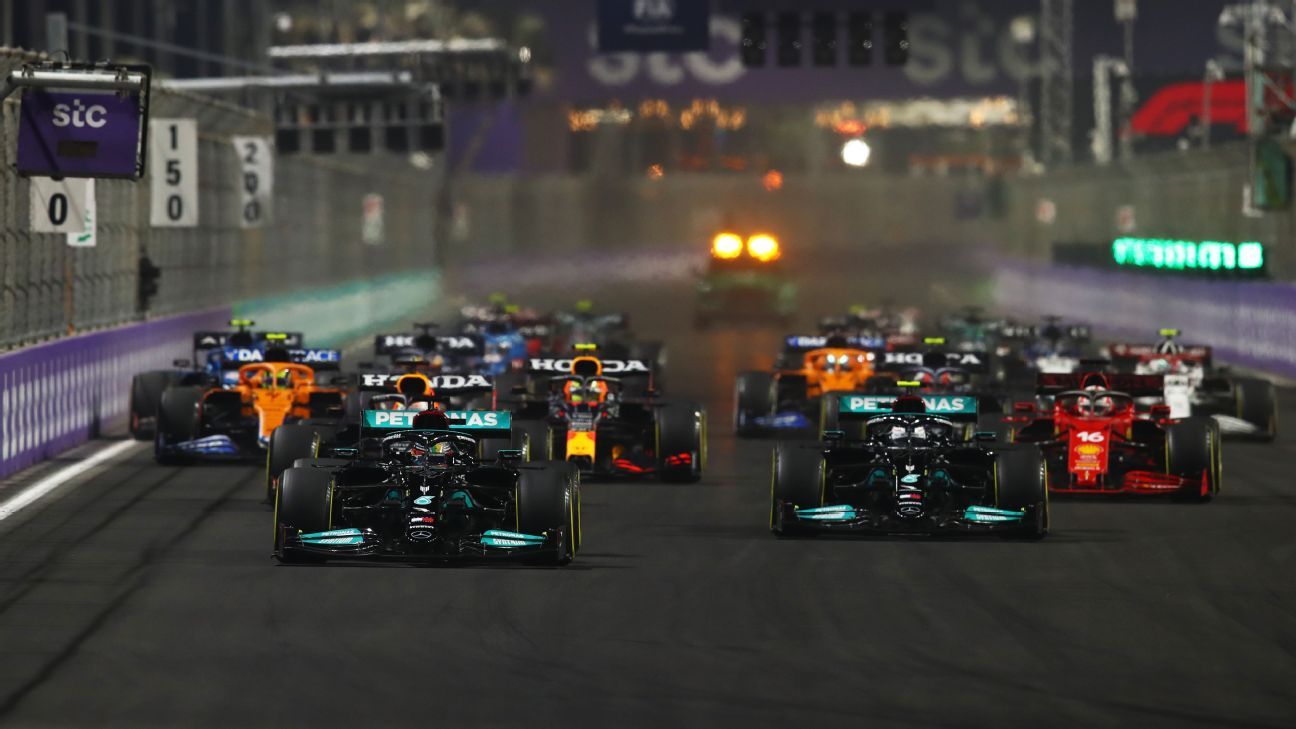Formula One is set to have a record 23 races this season.
The 2022 campaign follows on from one of the most incredible title battles in F1’s history, one which ended in controversy at the Abu Dhabi Grand Prix in December.
It seems like that campaign is barely over but the new season is already on the horizon.
Here’s everything you need to know.
What’s new?
The F1 cars which line up for the Bahrain Grand Prix on March 20 will look vastly different to those that finished the Abu Dhabi Grand Prix in December. F1’s aerodynamic overhaul, which was pushed back to 2022 due to the pandemic, comes into effect this year. F1’s teams have been working on their 2022 cars in the background for a long time and some will have switched focus to this project far earlier than others. F1 hopes its new cars achieve two key things:
-
The ability to follow another car more closely, creating more overtaking opportunities and improving wheel-to-wheel racing.
-
A much closer competitive order, with multiple teams in with a chance of winning and scoring a podium every weekend.
You can read Laurence Edmondson’s comprehensive guide to the new regulations here.
When will we see these new cars for the first time?
No team has confirmed when they will launch their new car, although it can safely be assumed most of them will do so in the week leading up to the opening day of the first test.
Some teams may opt to only release computer renderings of their car and reveal the real thing when it rolls out of the garage for the first time that morning.
Preseason testing
First test – Barcelona, Spain – February 23-25
Second test– Sakhir, Bahrain – March 10-12
F1 has set aside six days of testing this year, split across two different venues. The first three days will be at Barcelona’s Circuit de Catalunya, host of the Spanish Grand Prix, and Bahrain’s Sakhir International Circuit. Bahrain will host the opening race of the season one week after the second test has concluded.
Testing often provides a rough picture of what the competitive order looks like. This year it will be more crucial than ever, with any reliability issues likely to be hugely costly given the limited time on offer for all the teams to understand their new cars.
Is Hamilton going to be on the grid?
Lewis Hamilton has maintained completed silence on social media and in the media since he left the paddock in the hours after controversially losing the title to Max Verstappen on the final lap of the Abu Dhabi Grand Prix. Mercedes eventually decided not to pursue an appeal into the result of that race, with the FIA promising a comprehensive review of how race director Michael Masi handled the restart of the race.
According to Sky Sports, the outcome of that review will influence Hamilton’s decision on whether to continue, suggesting he and Mercedes would like to see a change in race director at the very least. It remains to be seen whether an FIA investigation into an FIA employee will yield any significant results.
All the indications ESPN has been given is that Hamilton will continue this year. Hamilton is looking for a record eighth world championship, which would move him clear of a tie with Michael Schumacher on the all-time list.
What does this record-breaking season look like?
This will be the biggest season ever in F1. It will feature a second race in the U.S., with May’s Miami Grand Prix joining the schedule for its debut event. Miami has signed a 10-year contract to host F1 races going forward.
The core of the calendar otherwise looks very similar to previous seasons, with the European races making up the centre of the schedule either side of the August summer break.
The season will finish at the Abu Dhabi Grand Prix on November 20, which is earlier than normal due to the scheduling of the football World Cup in Qatar, which starts the following day.
Bahrain Grand Prix – Sakhir – March 20
Saudi Arabian Grand Prix – Jeddah – March 27
Australian Grand Prix – Melbourne – April 10
Emilia Romagna Grand Prix – Imola – April 24
Miami Grand Prix – Miami – May 8
Spanish Grand Prix – Barcelona – May 22
Monaco Grand Prix – Monte Carlo – May 29
Azerbaijan Grand Prix – Baku – June 12
Canadian Grand Prix – Montreal – June 19
British Grand Prix – Silverstone – July 3
Austrian Grand Prix – Spielberg – July 10
French Grand Prix – Le Castellet – July 24
Hungarian Grand Prix – Budapest – July 31
Belgian Grand Prix – Spa-Francorchamps – August 28
Dutch Grand Prix – Zandvoort – September 4
Italian Grand Prix – Monza – September 11
Russian Grand Prix – Sochi – September 25
Singapore Grand Prix – Singapore – October 2
Japanese Grand Prix – Suzuka – October 9
United States Grand Prix – Austin – October 23
Mexican Grand Prix – Mexico City – October 30
Brazilian Grand Prix – Sao Paulo – November 13
Abu Dhabi Grand Prix – Abu Dhabi – November 20
Are sprint races still a thing?
Very much so. Having seen three “trial” runs last year at Silverstone, Monza and Interlagos, F1 wants to increase sprint races from three to six in 2022.
The venues for those sprint qualifying races – where qualifying is held on Friday, setting a grid for a shortened race on Saturday which sets the grid for Sunday’s grand prix – are yet to be revealed, although F1 is understood to be considering Bahrain, Imola, Montreal, Austria, Zandvoort and Interlagos.
